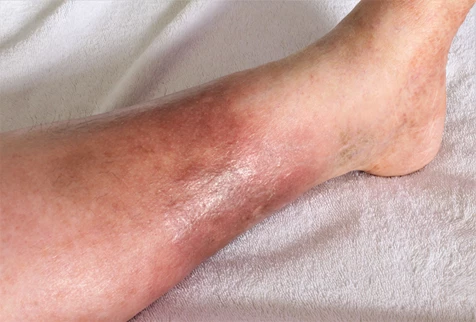Blood clots are a very rare side effect of using some types of contraception, such as the combined contraceptive pill. They can be very serious if ignored, but are both preventable and treatable. It’s important to know the symptoms to look out for so that you can get the medical help you need if you suspect you have a blood clot. In this article, we’ll outline what to be aware of, as well as explaining what blood clots look like and what you should do if you think you have one.
How do you know if you have a blood clot?
A blood clot occurs when the blood sticks to itself and forms a mass to prevent further blood flow. This is a vital process to prevent excessive bleeding when you have an injury such as a cut.. However if this clot gets stuck in arteries or veins, it can lead to painful symptoms and even serious complications if left untreated. The blood clot may be classed as a deep vein thrombosis (DVT) if it forms in a large vein. This is more common with blood clots which form in the legs, but may also occur in the arms, pelvis or other large veins.
Left untreated, blood clots can block arteries and veins, which leads to swelling as blood builds up behind the blockage. However, clots can also sometimes move through the blood vessels, through the heart and into the lungs before becoming stuck. A blockage in the lungs is known as a pulmonary embolism, and this can be fatal. For this reason, it’s important to know the symptoms of a blood clot so it can be caught early.
Symptoms of a blood clot include:
- Swelling in an arm or leg - usually accompanied by redness and warmth in the affected area
- Throbbing or cramping pain in the affected limb
- Sudden breathlessness
- A cough - especially if you’re coughing up blood
- Sharp chest pain, which may be worse when you breathe in
It’s also worth being aware of the risk factors that make it more likely that you could develop a blood clot. If you’re not familiar with the risk factors, you might dismiss a blood clot as nothing to worry about when you should be seeking medical attention. Things you might not realise can increase the risk of developing a blood clot include:
- Genetic influence (i.e. a family history of blood clots or thrombosis)
- Sitting or lying down for excessive periods of time (particularly if you physically struggle to move due to disability or injury)
- Being pregnant or having had a baby within the last six weeks
- Taking the combined contraceptive pill
What does a blood clot look like?

Asides from cramping or throbbing pain in the affected area, one of the most recognisable symptoms of a blood clot is inflammation. Although it is possible to have a blood clot in both arms or legs, it is unlikely, so you may be able to compare one limb to the other to check if it is swollen. Take note of other symptoms of inflammation such as red, sore skin and heat in the affected area - these can all be signs of a blood clot.
What to do if you think you have a blood clot
If you suspect you have a blood clot, it is in your best interests to seek medical attention regardless of whether or not you think you have any risk factors. Generally speaking, you should contact a non-urgent medical care team such as your GP or NHS 111, who can advise you on what to do next. They will help you to understand whether your symptoms are caused by a blood clot or something else, and can refer you for treatment if necessary.
However, if you are also suffering from the following symptoms, you should call 999 or go to A&E immediately:
- Sudden shortness of breath
- Coughing up blood
- Sharp stabbing chest pains
This is because these symptoms can be a sign that you have a pulmonary embolism or are at a greater risk of developing one, so you’ll need treatment as soon as possible. Once you have been treated, either by a non-urgent care team or otherwise, you will likely be advised on your condition and changes you may need to make to your lifestyle. Your care team may help you to set these changes in motion by referring you to specialists or liaising with your GP, for example.
Amongst other things, you’ll be advised to regularly exercise and stay hydrated to reduce the risk of clots developing. You may also be given medication to limit your blood’s ability to clot. Additionally, if you are currently taking the combined contraceptive pill, it may be recommended that you switch to another form of contraception.
Sources:
https://www.nhs.uk/conditions/blood-clots/
https://www.nhs.uk/conditions/deep-vein-thrombosis-dvt/
